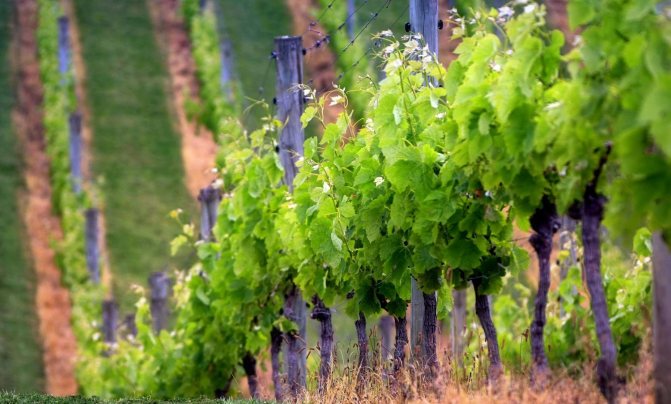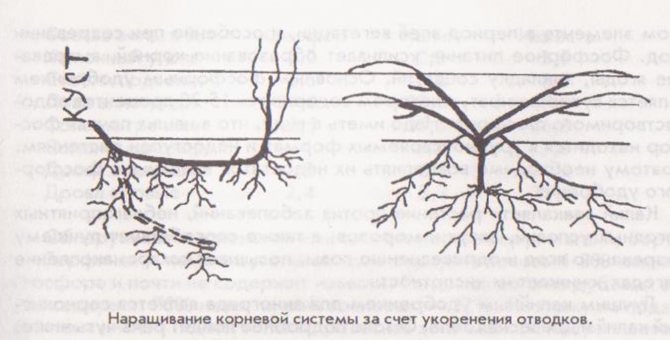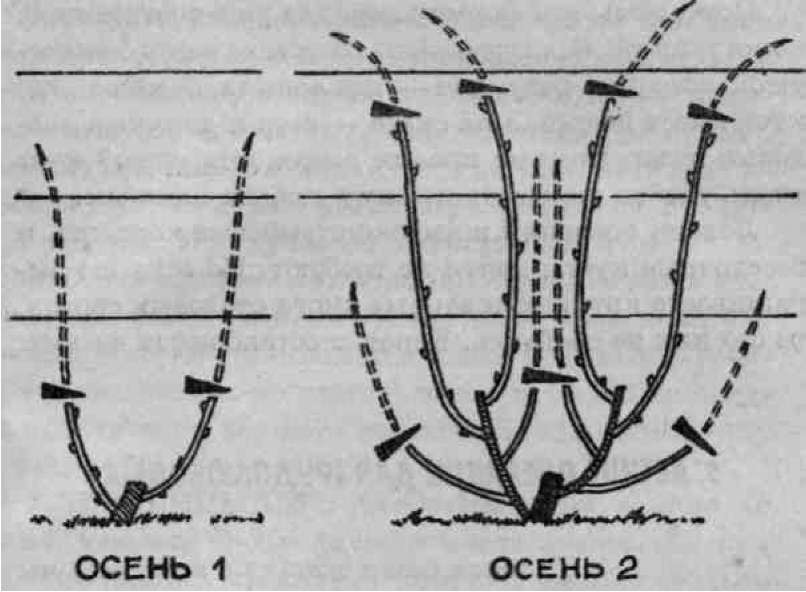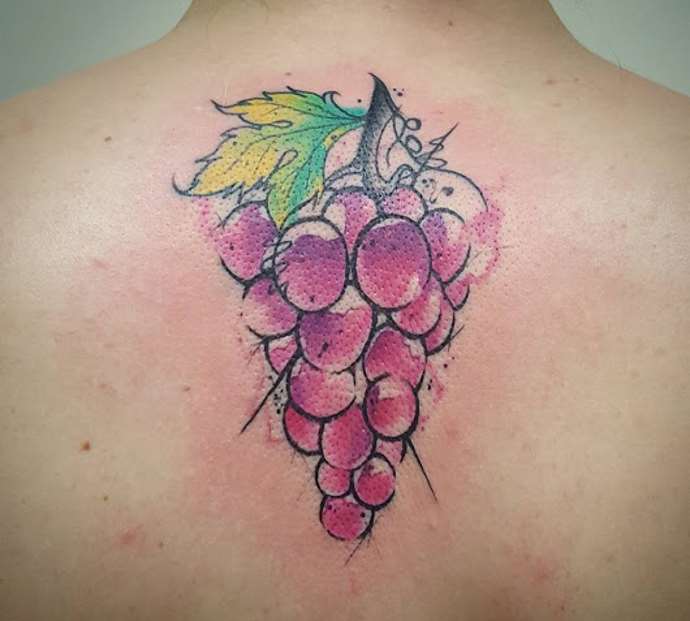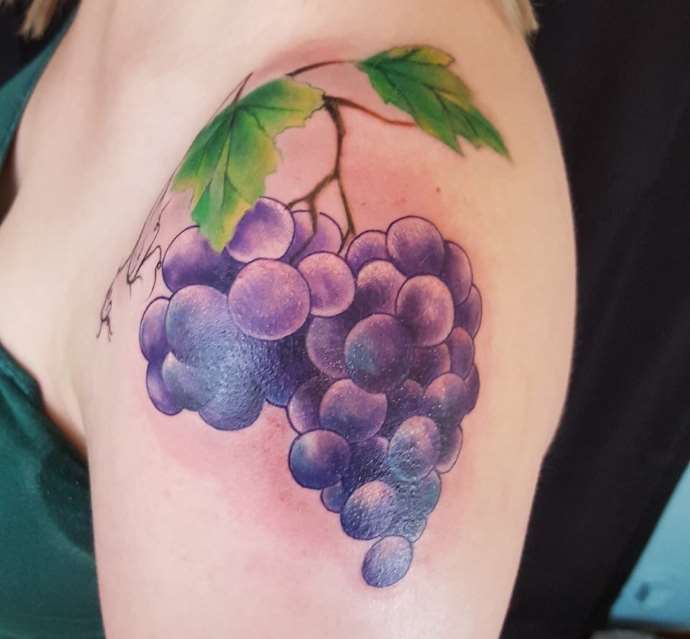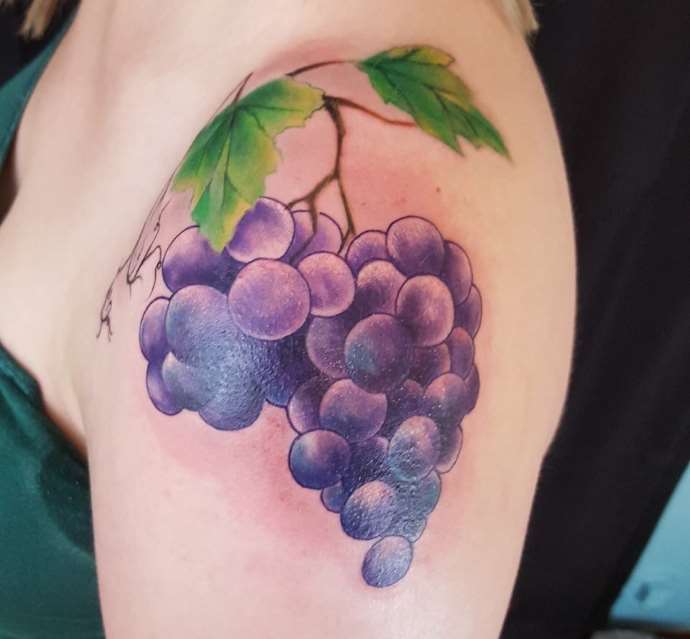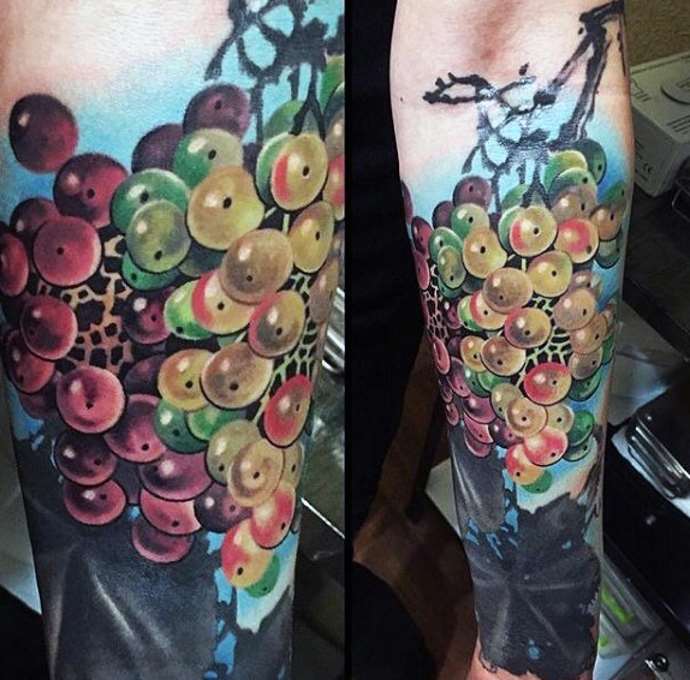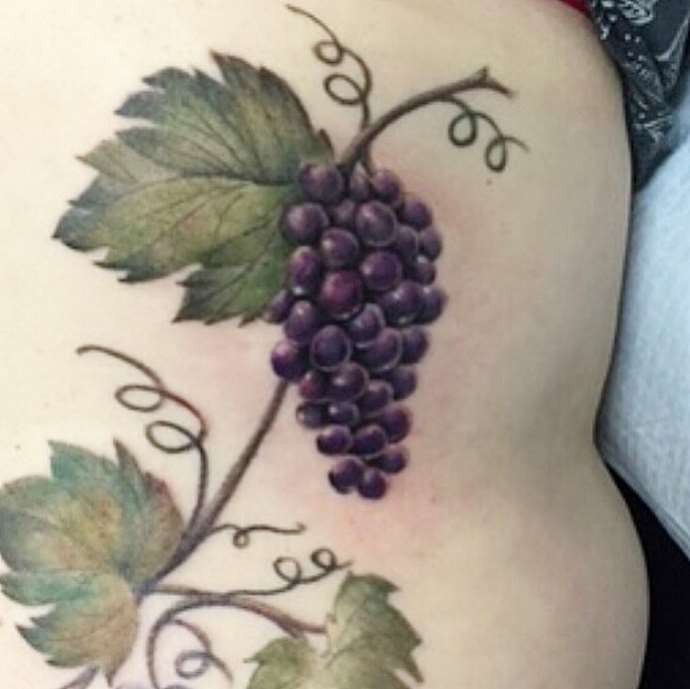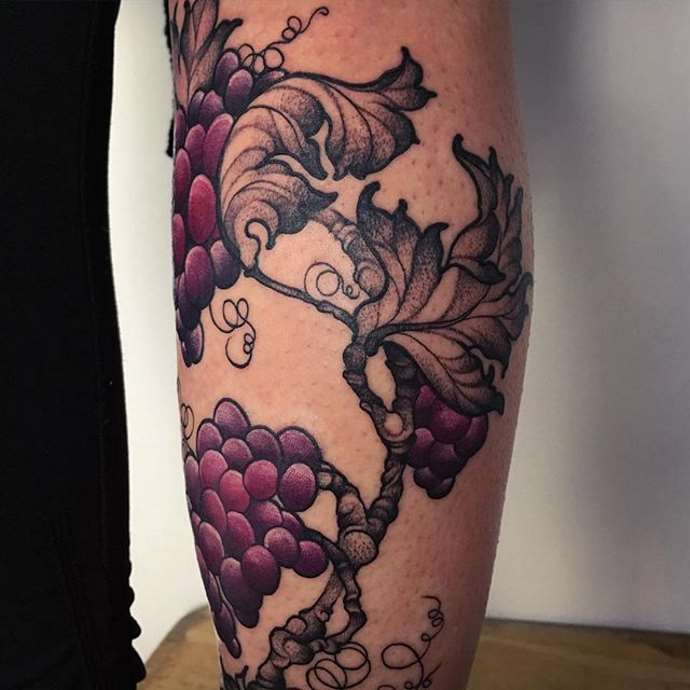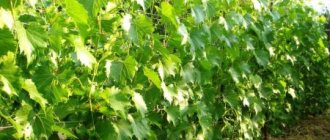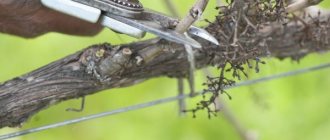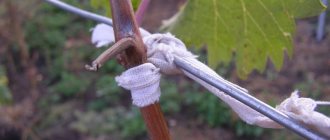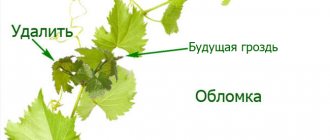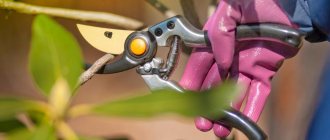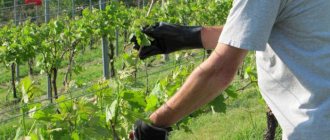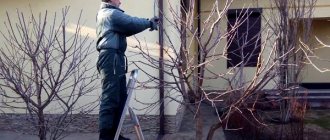Forming a vine bush is essentially pruning a vine according to a certain pattern. The correct formation of the future bush plays an important role in obtaining a future high yield. There are a huge variety of types and patterns of vine shaping, but the main principle is the creation of an artificial support (skeleton) along which the vines will be laid. The process of laying and pruning grape vines takes some time (several years), but the work on the result is worth the effort.
- General information
- Formation of a grape bush in three years
- Formation of a grape bush second year
- The third year of the formation of the grape bush
Forming a grape bush in different ways
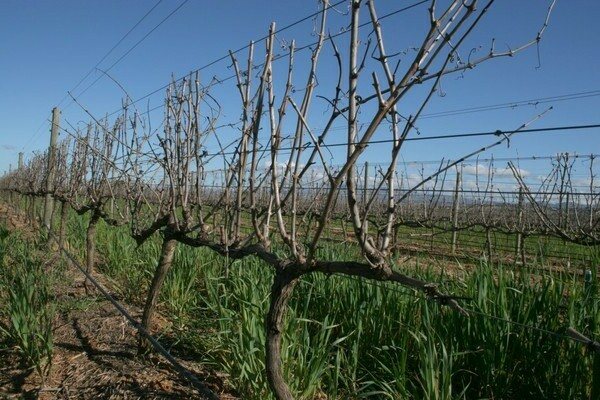
There are mainly four methods of shaping. They are quite different. Formation can be carried out:
- By fan. This method forms a bush that only consists of sleeves. As a rule, 6-7 branches are located on different sides. This method of formation increases the yield by 20-25%. The downside is that the space occupied by the grapes will have to be increased. In this way, you can increase the period when the plant will bear fruit. Thanks to this formation, the grapes will have many trace elements. They will be in stock. And also high immunity.
- Trunk. This method of formation is a little more complicated than the previous one. It requires more effort and space. But it will bear more fruit. With this formation, useful elements will accumulate in the plant trunk. The plant will develop better. And also bear fruit. Branches with this method grow at a level of 200 centimeters. Therefore, you do not need to tie them up. This form is less likely to be exposed to various diseases and pests. And also viruses. And every time the plant will become more beautiful. And also more hardy.
- Sleeves. The grapes that have been formed in this way take up little space. A branch is called a branch that bears many fruit-bearing vines. That is, it turns out that this branch is very easy to form. But if she lacks the necessary substances, she will become depleted. The shapes that are formed along the sleeves have existed for about 6-9 years. And also a small disadvantage is that the sleeves will have to be cut off constantly. Because they grow fast enough.
- Cordon. Cordon and shtamb are very similar to each other. Only the cordon is parallel to the ground. Although these methods are similar, the cordon is much more demanding to maintain. Because when formed in this way, the plant gets sick more often. But the plant tolerates wintering well. And also freezing. Therefore, it does not require any special cover. This formation also has its drawbacks. They consist in the fact that the grapes will not give a particularly large harvest. And also it will take up a lot of space. A cordon can have either one or two sides. The second will require even more space.
Note: There is a method called high-standard. It consists of two types. This is ideal for covering large areas. This type of formation is one of the most productive forms. Each can bear about 10-30 kilograms of fruit.
If you choose the type of formation, build on the existing weather conditions.In a warm winter period, you must use a stem. Use sleeves for small areas. On a large territory, you can use a fan or cordon.
Technique of execution
The stylistic decision should be determined by the choice of the sketch. Girls often choose a vine that wraps around a leg, shoulder or arm (see photo below). In this case, the baroque style is more suitable, which is characterized by original patterns, openwork lace, complex fancy ornaments. A monochrome tattoo will look stylish.
The grape fruits look spectacular in the style of realism (see the photo in the gallery after the article). Realistic tattoos are distinguished by detail, rich colors, and clear contours. The choice of a master should be approached responsibly, since this technique requires a high level of artistic skill.
Watch an interesting video
Tattoo photo gallery
Crop pruning
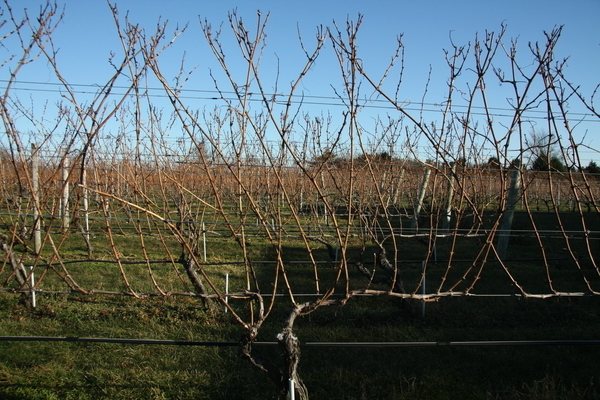

After general information about the formation, you should study the detailed instructions for the formation. The grape has a fairly strong and loose wood with pores. Therefore, when shaping, a pruner with a very sharp blade must be used. Otherwise, the bark will be damaged, scratched. And also she will lose a large amount of her juices. The sleeve of the grapes should be cut higher than the bud. If you do it lower, then the distance from the kidney to the cut will be too small. And the wind will blow into the kidney.
In the summer, special attention is paid to the fruit arm. Or rather, its formation. Each such sleeve must have two vines. Namely: a long and short vine. A green shoot will grow from the short vine in the future, which will become a vine. A shoot will grow from a long vine, bearing fruit.
Possible mistakes
Usually, incidents occur during the preparation of cuttings for planting in open ground. Professionals identify 3 main mistakes:
Cuttings in cups
- During the autumn harvesting, a person allows the twigs to dry out. The bottom line is that the branches will simply lie all winter, and in the spring they will become unsuitable for growing.
- Wrong timing for germination. The roots germinate from 3 weeks to 1 month. If you root the shanks early, you will have to spend a lot of time and effort growing seedlings at home. For example, in northern regions it is better to start such a procedure at the end of February, and in warm regions - in mid-January.
- Incorrect temperature. It is important to remember one rule here: the temperature at the heel of the branch should be higher than at the top. Otherwise, the eyes will begin to grow rapidly and use up all their nutrients before the root system begins to form. If the shank does not die, then there will still be no benefit from it.
Formation of a grape bush with a sleeve in the first year
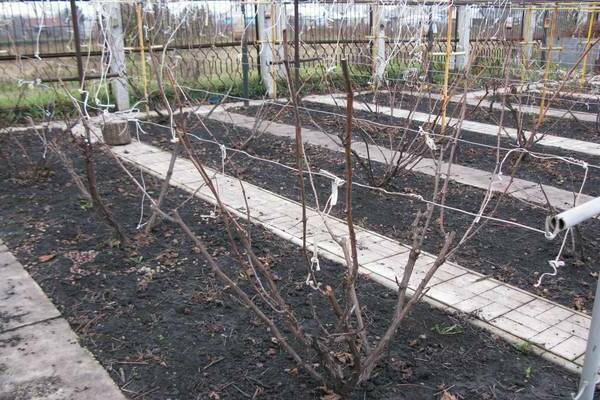

- First you need to choose the strongest vines. The length is usually 15 or more centimeters.
- In the future, all this will break into pairs. Therefore, the paired vines should grow side by side.
- Cut one vine shortly, leaving 2 buds. Leave the second vine alone. But it should have 7-10 kidneys.
- In the fall of next year, you need to prune the long vine along with the rest of the shoots.
- After the vines are fully grown, it is necessary to carry out the formation in the same way.
This operation is repeated annually. Thanks to her, the grapes will bring a great harvest. With this formation, the grapes do not overgrow. This formation is considered very simple. Therefore, it is suitable for beginner gardeners.
In autumn
Planting material should be harvested in the fall, when the vine is pruned. It is important to complete the procedure before the first frost begins.
How to choose a suitable escape?
The choice of a suitable vine is a very important stage, since it is through the vine that you transfer all the genes of the grapes, from the amount of harvest to the very fruits, and it is through the harvested stem that you can transfer existing diseases from the old bush.
Be sure to check if there are any signs of any diseases on the harvested vine.
The vine itself must be ripe, bearing fruit at least once, have healthy kidneys. Material thickness 12 mm, with 10 cm internodes.
How to cut?
- Harvest the shanks only from the middle parts of the shoot.
- Leave the cut angle the same as in the spring version.
- Remove all leaves and whiskers from the cutting, leave 2-4 buds each.
- Make 3-4 grooves on the sides with a sharp object (nail or needle).
You can determine the quality of the material as follows: the shank should be firm to the touch, not have mechanical damage and brown specks. There is a green color at the slice level.
Important points
It is recommended to free the branches from all that is superfluous, to leave only 4 functioning buds. Cut the material with a sharpened pruner or knife so as not to damage the shanks. It is better to pre-treat the instrument in a disinfectant solution (1% potassium permanganate). Here are some more important nuances:
- Length. The stalk should not exceed 70 cm in length.
- Thickness. A good diameter is considered to be from 6 cm to 10 cm (no more and no less).
- Disinfection. Treat the twigs with a 3% solution of copper sulfate. Dry, tie and store.
- Soak. Before disinfection, the cuttings should be soaked in clean water for 1 day so that the wood can be saturated with a sufficient amount of moisture.
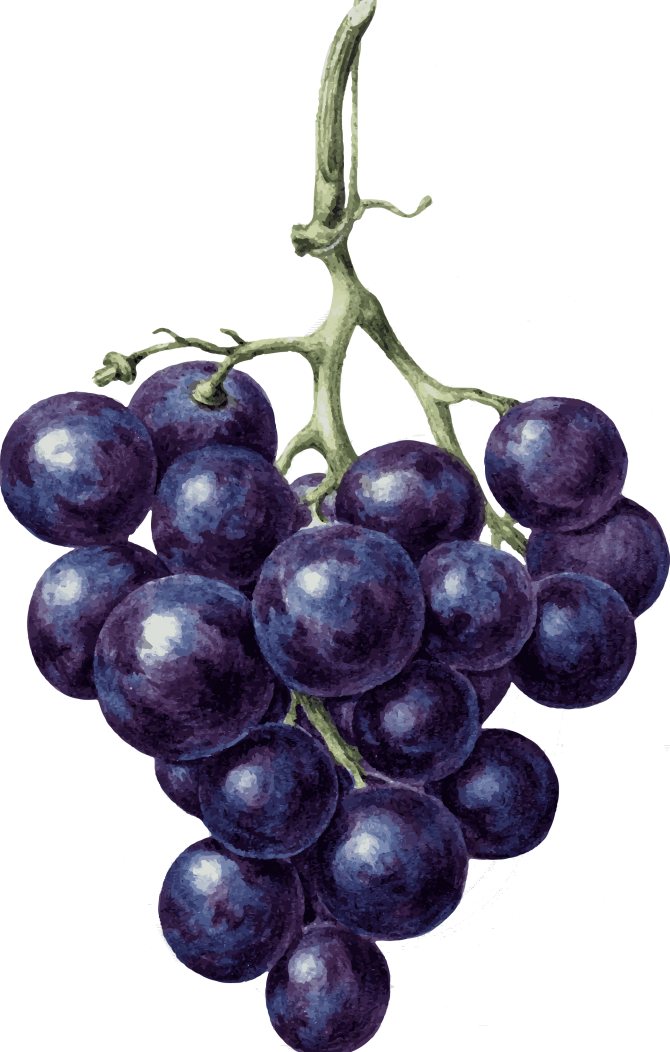

The next very important point during autumn harvesting will be to properly preserve grape cuttings for their subsequent germination. Each of these three stages is very important and does not go without one.
Forming a grape bush in a fan
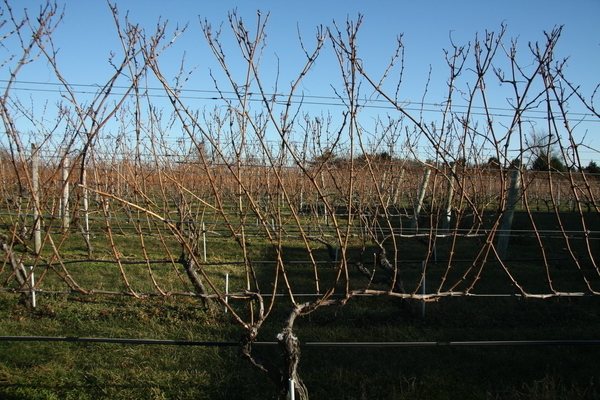

For this formation, use two sleeves that are directed away from each other. The number of sleeves can be larger if there is a large free area. Each sleeve needs 1 meter on the trellis.
First you need to choose one strong branch about 1 meter long. Or a little longer. This branch should have 12 vines. Then they will break in pairs. They will all serve as fruit sleeves in the future. All unnecessary is cut off. A sleeve must be formed from above. Certain substitutes should be left in a slightly larger amount. Their length should be small. If you are leading a stem, then you should tie it to a strong support before a sufficiently wide trunk is formed.
Care of cuttings
Seedling care involves regular watering and spraying.
When caring for them, you should follow the rules:
- Provide moderate soil moisture.
- Do not forget to fight the emerging weeds.
- Use complex fertilizers for feeding seedlings. After a week, the planted plants are fed with potassium, wood ash.
- Observe the lighting regime.
- Carry out periodic treatment from pests.
The correctness of rooting is indicated by the development of the root system earlier, the appearance of greenery (leaves). The opposite scheme indicates a violation of the process.
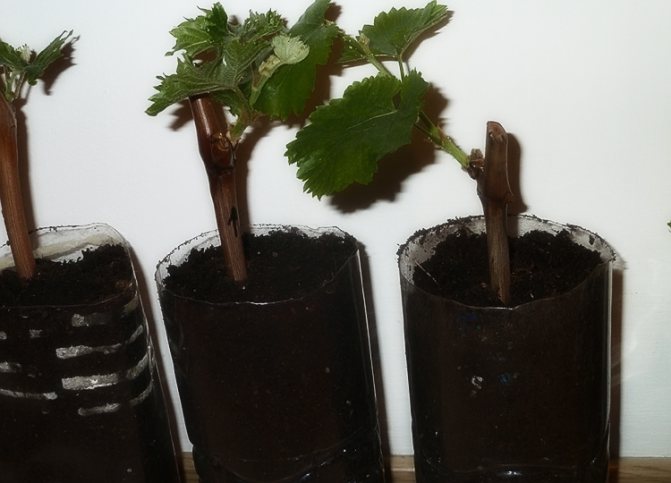

Humidity and watering
Care rules provide for high humidity. For this purpose, spraying with warm water (20-25 °) is recommended up to 5 times a day. Starting from 10-12 days, when root rudiments appear, reduce the number of sprays to 3 per day.
Watering is carried out as the soil mixture dries up (1-2 waterings per week). It is produced through a pallet in order to avoid decay of the root system.
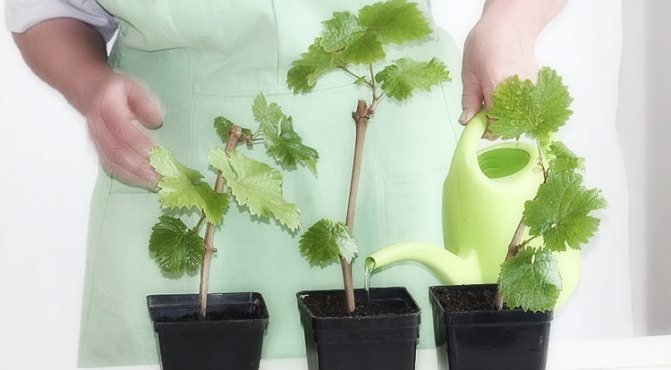

Temperature regime
To germinate cuttings in water, the outside temperature requires about 20 °, and inside the jar - up to 38 °.At high temperatures during the storage period of germinated cuttings, the intensity of nutrient consumption increases. This is fraught with loss of vitality by the time of rooting. And extremely low temperatures lead to freezing, drying of the eyes. The optimum temperature for the preservation of cuttings is from 0 to 5 °.
Light for cuttings
Keep the container with shanks in a bright place, but exclude direct sunlight. They can provoke grape leaf burns.
The use of fluorescent lamps is considered effective.
Preparation for planting in open ground
In the spring, the material prepared earlier is processed, debris, rotten, dried out shanks are removed. When cut, the stalk should be light green and sap. Otherwise, the material is unsuitable for planting in open ground.
To prepare for planting, the seedlings should be hardened (about a week before planting). To do this, when the formation of the root system is completed (after a few weeks), you need to open the container for 10-12 minutes, adding time until it is fully disclosed. The hardened seedlings are ready to be transplanted into a permanent place. It can be started with 2-3 sheets and formed white roots (formed root system).
Formation of a bush of adult grapes
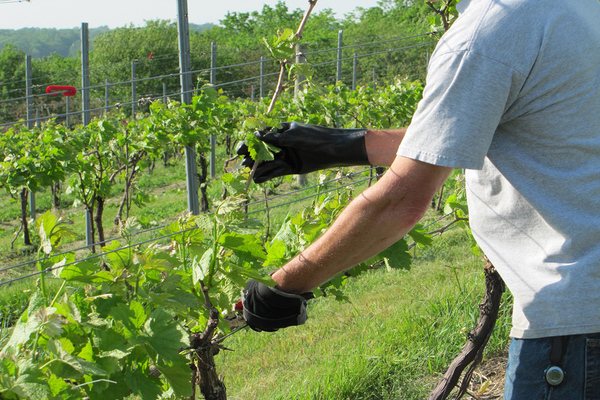

The previously described forming methods are used only for young grapes. A special scheme is used for mature plants. It must be complemented by proper, thorough care.
First you need to clean the bottom of the grapes, ensuring a good blowing. That is, weak vines should be removed. Then you need to determine how many meters the bush will need for comfortable development and growth. The size of the space should be considered with the possibilities. If there is an arch, then it should be formed with a boom, cordon or fan.
After that, you need to cut off several vines along their internodes, using a sharp pruner. Grapes are a very delicate plant. It should be formed only with reliable, special tools. Then you need to create fruit links, choosing several vines each year. It turns out that more than two fruit arms are formed.
Formation with a stem or cordon should be carried out especially. The sleeves should be formed at the end of the branch. And not at the foundations. When summer comes, the shoots should be tied to a trellis. With the onset of cold weather and harvesting, vines with lashes must be cut off, leaving a couple of new ones. Then one sleeve is cut almost completely. Only 2 kidneys remain. And the other remains unharmed.
This operation should be performed annually. Because this will prevent the grapes from overgrowing. If you do not have enough time to trim the grapes, then you can shorten it. To do this, you need to leave only large vines that have already ripened. And cut off the rest. After such pruning, the bush will look much more cultured than before.
Preparing cuttings for planting
The prepared shanks are sorted and processed. Processing consists of the following actions:
- daily soaking in water;
- etching (disinfection) with copper sulfate 5%;
- drying;
- sorting, bundling;
- wrapping with polyethylene film;
- determination in a cool storage location.
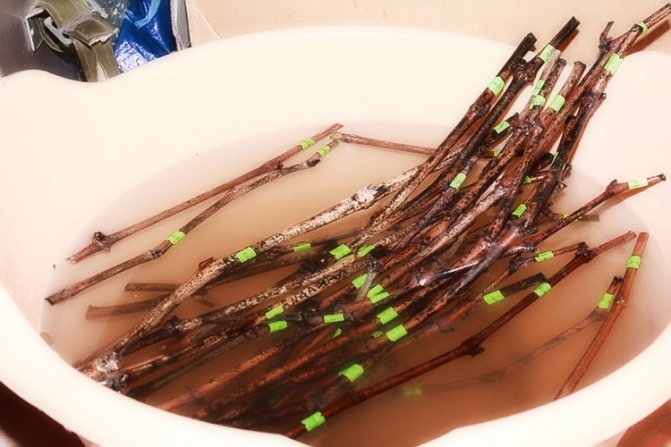

The storage room temperature should not exceed 5 ° throughout the winter. Excessive moisture in the storage area can cause rotting. Culling should be carried out in a timely manner.
Preparation stages
- The preparatory period includes several stages:
- Proper storage after pruning
- Subject to the storage rules, the amount of rejected material decreases significantly.
It should be provided:
- cleansing of mustaches, small stepsons, foliage;
- the formation of bundles when tying with a rope (non-rigid wire);
- content in the wet sand of the basement (or in an equipped trench).
Trench Equipment Rules
The hole should correspond to the length of the shanks. It cannot be near groundwater. About 9-10 cm of sand is poured onto its bottom. The soil layer above the cuttings must be provided up to 40 cm. To avoid freezing, insulate with leaves, straw, sawdust and cover with polyethylene film.
In the refrigerator, the optimal temperature storage space for planting material is the door. Before laying for storage, the material is soaked for up to 2 days in cold water, placed in a polyethylene bag. The shanks are taken from the storage in February (possible from the end of January).
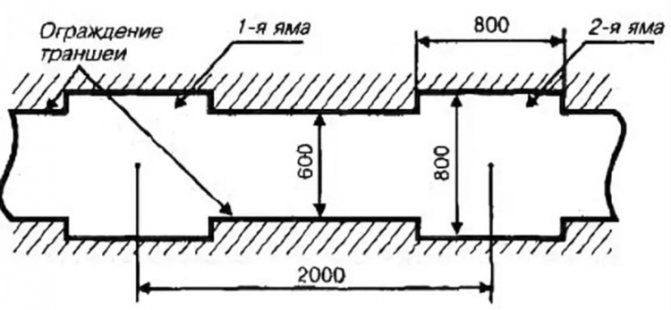

Processing and furrowing
After removal from the storage, washing is carried out in a solution of potassium permanganate of low concentration. The cut sites are lightly trimmed with a pre-disinfected knife to light green skin.

